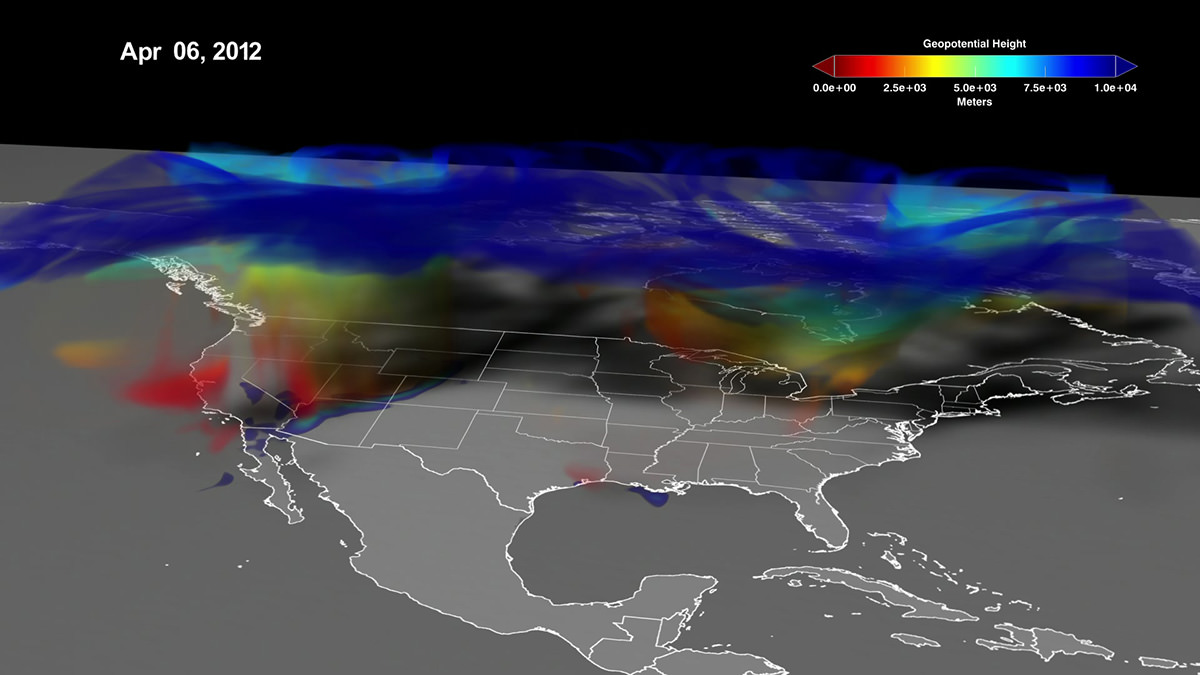The Cowboy State boasts that it’s “like no place on Earth.” It’s not hard to see why – with a mean elevation of more than 6,600 feet (2,011 meters), only Colorado is loftier. This altitude can occasionally cause problems for air quality, however, as Thunder Basin, Wyoming found out when high levels of atmospheric ozone descended into this remote, sparsely populated corner of the state.
Stratospheric ozone is often called "good" ozone. It normally circulates in one of the upper levels of Earth's atmosphere, providing a vital shield against harmful solar radiation. Elevated levels of ozone in the lower atmosphere, where we breathe, is often called "bad" ozone and usually comes from human-caused sources such as smog or related polluting factors. But in this unusual instance, the stratospheric ozone intruded lower into the atmosphere, in a phenomenon called a "stratospheric intrusion."
When this happened, surface monitors in Wyoming showed that the concentration of ozone in the air reached nearly 100 parts per billion (ppb), with 8-hour averages registering above the 75-ppb public health standard established at the time by the Environmental Protection Agency (EPA). In the years following, the EPA lowered the standard even more, to 70 ppb.
Brad Pierce is a scientist stationed at the University of Wisconsin-Madison Space Science and Engineering Center (SSEC) in Madison, Wyoming. Pierce is one of the principal investigators of what is now called the NASA Earth Applied Sciences's Health and Air Quality Applied Sciences Team (HAQAST). His expertise in stratospheric intrusions includes helping scientists use satellite data to study ozone.
“In this case,” Pierce said, “the state of Wyoming needed to prove that the elevated ozone readings … were caused by an intrusion of stratospheric air rather than pollution, otherwise they would be in violation of the Clean Air Act.”
The Clean Air Act requires maintaining the National Ambient Air Quality Standard (NAAQS) for ozone. If there is a violation, EPA may designate areas that need plans for improvement in air quality. However, EPA can exclude heightened ozone levels caused by exceptional events (usually from natural sources) if they are explained by appropriate documentation.
The Wyoming event provided an opportunity for Pierce and the team to apply some new strategies using both satellite and surface observations to determine the source of the increased ozone levels.
“IDEA-I will help us forecast these events by using satellite measurements to identify cases that could be stratospheric intrusions, based on satellite ozone, temperature and water vapor retrieval.”
–Brad Pierce, University of Wisconsin-Madison and NASA’s Health and Air Quality Applied Sciences Team
“We were looking for evidence that the ozone of the Thunder Basin event came from the stratosphere,” Pierce explains. “We ran back-trajectories, backward in time, to see where that air came from. The back-trajectories went back to a very persistent cyclone circulating around the Aleutians. These high amplitude troughs that we often see over California in the springtime come off of the Pacific.” He added, “Then, because of the high topography, the ozone that comes in with these troughs will often affect the western mountain states.”
The team’s primary tool for determining the stratospheric intrusion was the Infusing satellite Data into Environmental Applications-International (IDEA-I) partnership, developed by NASA, EPA and the National Oceanic and Atmospheric Administration (NOAA). Using the evidence gathered by Pierce and others, the state of Wyoming Department of Environmental Quality Air Quality Division filed a report documenting why exceeding the EPA standards in the Thunder Basin was an exceptional event. In this case, the elevated ozone level was the result of a natural occurrence and not pollution.
Interestingly, this back-trajectory technique can also predict exceptional events like this down the road, Pierce explained. “This same technique is what we use to do forward-trajectories. IDEA-I will help us forecast SI events by using satellite measurements to identify cases that could be stratospheric intrusions, based on satellite ozone, temperature and water vapor retrieval.”
This forecasting of when unusual "dips" of atmospheric ozone descends into Wyoming is an ongoing project by Pierce and his team with NASA HAQAST, all to ensure that future instances like this are carefully monitored.
This story is part of our Space for U.S. collection. To learn how NASA data are being used in your state, please visit nasa.gov/spaceforus.




